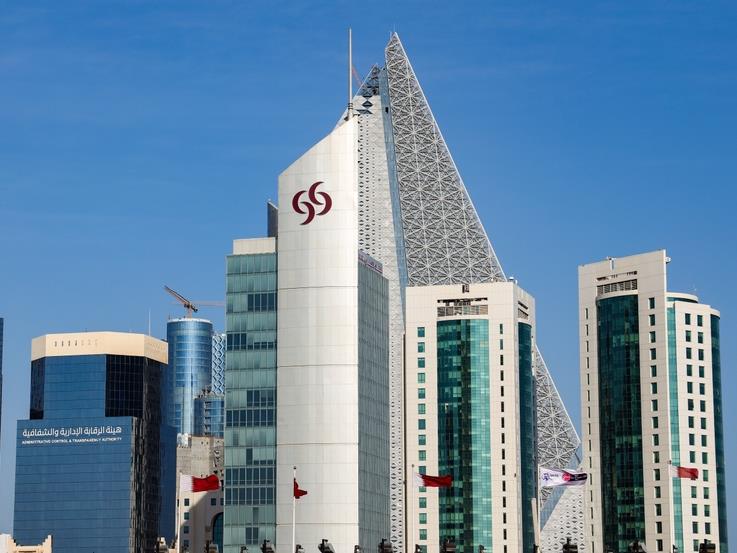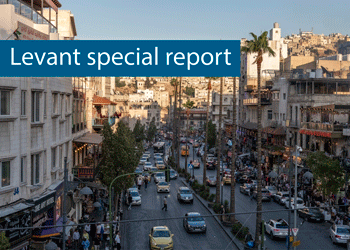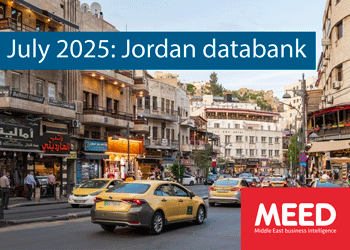Wood shares drop after financial warning
3 April 2025
Shares in the UK-based engineering company Wood Group dropped by 25% after it announced that accounting issues would delay the publication of its full-year results for 2024.
The company, which has numerous project contracts around the Middle East and North Africa, said it had identified “material weaknesses and failures” in its financial culture within its projects business unit, following an independent review conducted by financial services company Deloitte.
Wood said the failures included “inappropriate management pressure and override to maintain previously reported positions”, and led to instances of information withheld from Wood’s auditors.
It also said there was an inappropriate “over-optimism and/or lack of evidence in respect of accounting judgements”.
Wood has project contracts in Iraq, Kuwait, Oman, Qatar, Saudi Arabia and the UAE, where the company opened its third office in Sharjah.
The firm’s regional projects pipeline includes pre-front-end engineering and design (pre-feed) work on Saudi Aramco’s Southern and Northern Areas project in Saudi Arabia.
It is also working on an integrated feed, detailed design, procurement support, and construction and commissioning assistance for TotalEnergies in Iraq.
In its latest statement, Wood said: “We are committed to implementing a detailed remediation plan, including necessary follow-on actions from the review, to continue to strengthen the group’s financial culture, governance and controls.
“This will include actions on culture, controls and organisational structure.”
As a result of the initial report from Deloitte, Wood said:
- A number of prior year adjustments are expected to be required for the income statement and balance sheet
- Issues identified in a limited number of contracts in the Projects Business Unit, particularly in relation to legacy lump-sum turnkey projects
- Issues with the application of relevant accounting standards, such as holding specific amounts on the projects balance sheet that should have been written off
- Gaps and deficiencies within the application of controls, which relate to the monitoring and reporting of project positions within the Projects Business Unit
- No material issues identified in our other business units (Consulting, Operations and Investment Services)
Extensive work is needed to conclude the audit, according to Wood.
The company has said that it is now expected to have to delay the publication of its full-year accounts and will not publish them for 2024 by 30 April 2025 as was previously expected.
It also said that if the publication of its results is delayed, the company’s shares will be suspended from trading from 30 April 2025 as work progresses towards completion of its FY24 accounts.
Commenting on its engagement with lenders, Wood said: “We remain in constructive dialogue with the group’s lenders regarding refinancing options and will engage with lenders in respect of the timing of our FY24 accounts, including putting in place appropriate pre-emptive waivers under our committed debt facilities.”
Last month, Wood said it had extended the deadline for talks regarding a possible takeover by Dubai-based Dar Al-Handasah Consultants Shair & Partners Holdings (Sidara).
The new deadline was set for 17 April.
In its latest statement, Wood said that it remains in discussions with Sidara about a possible cash offer for “the entire issued and to be issued share capital of the company”.
Exclusive from Meed
-
 Turkish Airlines plans further growth
Turkish Airlines plans further growth1 July 2025
-

-

-
 Levant states wrestle regional pressures
Levant states wrestle regional pressures1 July 2025
-
 Jordan’s economy holds pace, for now
Jordan’s economy holds pace, for now1 July 2025
All of this is only 1% of what MEED.com has to offer
Subscribe now and unlock all the 153,671 articles on MEED.com
- All the latest news, data, and market intelligence across MENA at your fingerprints
- First-hand updates and inside information on projects, clients and competitors that matter to you
- 20 years' archive of information, data, and news for you to access at your convenience
- Strategize to succeed and minimise risks with timely analysis of current and future market trends

Related Articles
-
 Turkish Airlines plans further growth
Turkish Airlines plans further growth1 July 2025
 This package on UAE-Turkiye relations also includes:
This package on UAE-Turkiye relations also includes:> UAE-Turkiye trade gains momentum
> Turkiye’s Kalyon goes global
> UAE-Turkiye financial links strengthen

With a network covering 30 more countries than its closest competitor, Turkish Airlines has been recognised by Guinness World Records for the most countries flown to by an airline since 2012. “Over the past two decades, Turkish Airlines has experienced rapid expansion, becoming one of the world’s most recognised airlines and the largest carrier in terms of destinations served,” says Erol Senol, vice-president of sales at Turkish Airlines.
The airline’s growth has meant it has become a competitor for the major Gulf carriers such as Emirates, Qatar Airways and Etihad. Senol says the growing aviation market offers opportunities for all carriers.
“The global centre of aviation is moving from the west to the east,” he says.
“This change is advantageous for all regions and carriers, provided there is the commitment to serve more effectively.”
 Extending reach
Extending reachLike the airlines in the Gulf, Turkish Airlines is based in a strategically important geographic location. “Istanbul is within a three-hour flight distance to 78 cities in 41 countries, making it a central hub for connections between Europe, Asia and Africa,” says Senol.
Since 2019, the airline has also been based at one of the world’s largest airports, Istanbul Grand airport (IGA), which has enabled it to continue growing.
“The transition to Istanbul Grand airport has marked a new era for Turkish Airlines, enabling the company to sustain its ambitious growth trajectory,” says Senol.
“Approximately 80% of its capacity is dedicated to Turkish Airlines, offering the airline the operational flexibility and technological support required to manage large-scale passenger and cargo flows.”
The congestion and capacity limitations that previously constrained operations at Ataturk airport were effectively resolved through this relocation.
“Aircraft movement capacity increased from 70 per hour at Ataturk to 80 at the initial stage of Istanbul airport, eventually reaching 120 movements an hour with the commissioning of the third runway. This has significantly reduced aircraft waiting times from 5% to below 1%, improving both punctuality and fuel efficiency,” he adds.
IGA’s larger footprint, which Senol says is “seven times larger than Ataturk airport” has also enhanced passenger services and facilities, helping to improve customer satisfaction and streamline operations.
Turkish Airlines has also increased its annual cargo handling capacity from 1.2 million tons at Ataturk to 2.5 million tonnes at IGA, with projections of reaching 5-6 million tonnes as the airport develops further. “Turkish Airlines has advanced from ninth place in 2018 to third place in 2025 in global air cargo traffic rankings,” says Senol.
Supporting the cargo business is Turkish Cargo’s airport facility, SmartIST, which began operations in February 2022. In 2024, cargo volumes at SmartIST increased by 20% compared to 2023, reaching 1.99 million tonnes. Based on freight tonne kilometres, Turkish Cargo says its market share has reached 5.7%, ranking it third globally. Market share rose to 5.8% in the first quarter of 2025.
A second phase of expansion will further enhance Turkish Cargo’s operations capacity, allowing it to handle up to 4.5 million tonnes annually. The long-term target is to reach 3.9 million tonnes of cargo by 2033.
The relocation of Turkish Airlines’ operations to IGA presented many challenges.
“The relocation project involved extensive pre-planning and meticulous attention to detail,” says Senol.
One of the key challenges was maintaining uninterrupted flight operations during the transition. With real-time monitoring and contingency planning, Turkish Airlines completed the transfer within 33 hours.
The transition to Istanbul Grand airport has marked a new era for Turkish Airlines, enabling the company to sustain its ambitious growth trajectory
Erol Senol, Turkish AirlinesFuture growth
With major airport projects planned at other hubs, Senol offers some advice on how to ensure a seamless transition of operations. “Airlines should invest in full-scale simulations and contingency rehearsals well before the actual move, including load testing IT systems, coordinating logistics and stress-testing operational workflows,” he says.
“Success hinges on strong coordination across departments – operations, IT, cargo, ground services, human resources, safety and more. Turkish Airlines created interdisciplinary task forces and embedded decisionmakers in each operational unit to allow for real-time problem solving during the transition.
“A relocation isn’t just physical – it’s digital,” he notes. “Turkish Airlines used the move to accelerate digital transformation: implementing contactless systems, integrating cargo automation and upgrading passenger services. Airlines should use relocation as a catalyst to modernise infrastructure and adopt scalable technologies.”
Another factor is having room to grow. “Airlines should ensure their new base is not just sufficient, but expandable,” Senol adds.
By 2033, Turkish Airlines aims to serve 171 million passengers across 400 destinations with a fleet of 813 aircraft. “Our strategic plan is built on an annual average growth rate of 7.6%,” he says.
Turkish Airlines currently operates 481 aircraft, comprising 134 wide-body and 347 narrow-body planes. The airline has also placed orders for 355 new Airbus aircraft – 250 A321 Neos and 105 A350s – to support its growth strategy.
https://image.digitalinsightresearch.in/uploads/NewsArticle/14178357/main.gif -
 Qatar records largest local-currency bank bond issuance
Qatar records largest local-currency bank bond issuance1 July 2025
Register for MEED’s 14-day trial access
Qatar-based Commercial Bank has completed a QR500m ($137m) senior unsecured bond sale, marking the largest local-currency issuance by a Qatari bank to date.
The three-year bonds, priced with a 4.9% coupon, were issued under the bank’s Euro Medium Term Note (EMTN) programme. The notes are listed on Euronext Dublin. DBS Bank and Standard Chartered acted as joint lead managers.
The deal attracted strong demand from both regional and international investors, as lenders across the Gulf continue to diversify their funding bases amid high interest rates, Commercial Bank said in a statement.
The issuance comes as Qatar’s domestic debt market gains momentum, with banks seeking to tap liquidity in both riyal and hard currency formats.
Commercial Bank is rated A2 by Moody’s, A– by S&P, and A by Fitch, all with stable outlooks. The lender reported a net profit before tax of QR704.3m for Q1 2025, down from QR801.6m in the same period last year.
https://image.digitalinsightresearch.in/uploads/NewsArticle/14177167/main3557.jpg -
 New Murabba signs MoU for project delivery solutions
New Murabba signs MoU for project delivery solutions1 July 2025
Saudi Arabia’s New Murabba Development Company (NMDC) has signed a memorandum of understanding (MoU) with South Korea’s Naver Cloud Corporation to explore technological solutions for delivering its 14 square-kilometre (sq km) New Murabba downtown project.
New Murabba CEO Michael Dyke signed the agreement earlier this week during the company’s Investment and Partnership Forum in Seoul.
According to an official statement: “The three-year agreement covers exploring innovative technology and automation to support the delivery of New Murabba, including robotics, autonomous vehicles, a smart city platform and digital solutions for monitoring construction progress.”
NMDC is in Seoul to examine technological offerings, assess financing options and showcase the investment opportunities available for the New Murabba downtown development.
The statement added that the excavation works for The Mukaab, the centrepiece of the overall development, have now been completed.
The Mukaab is a Najdi-inspired landmark that will be one of the largest buildings in the world. It will be 400 metres high, 400 metres wide and 400 metres long. Internally, it will have a tower on top of a spiral base and a structure featuring 2 million square metres (sq m) of floor space designated for hospitality. It will feature commercial spaces, cultural and tourist attractions, residential and hotel units, as well as recreational facilities.
Downtown destination
The New Murabba destination will have a total floor area of more than 25 million sq m and feature more than 104,000 residential units, 9,000 hotel rooms and over 980,000 sq m of retail space.
The scheme will include 1.4 million sq m of office space, 620,000 sq m of leisure facilities and 1.8 million sq m of space dedicated to community facilities.
The project will be developed around the concept of sustainability and will include green spaces and walking and cycling paths to promote active lifestyles and community activities.
The living, working and entertainment facilities will be developed within a 15-minute walking radius. The area will use an internal transport system and will be about a 20-minute drive from the airport.
The downtown area will feature a museum, a technology and design university, an immersive, multipurpose theatre, and more than 80 entertainment and cultural venues.
https://image.digitalinsightresearch.in/uploads/NewsArticle/14177612/main.jpg -
 Levant states wrestle regional pressures
Levant states wrestle regional pressures1 July 2025
 Commentary
Commentary
John Bambridge
Analysis editorThe Levant countries of Jordan, Lebanon and Syria are all in various degrees of distress, and collectively represent the Israel-Palestine-adjacent geography most severely impacted by that conflict, including in the latest phase initiated by Israel’s attack on Iran. In all three cases, however, recent developments have provided tentative hope for the improvement of their political and economic situations in 2025.
In the case of Lebanon, still reeling from Israel’s invasion and occupation of the country’s southern territories in retaliation for Hezbollah’s missile attacks on northern Israeli cities, the hope has come in the form of the country’s first elected president since 2022, and a new prime minister.
The task before both leaders is to stabilise a deeply fragile political and economic situation while avoiding further degradation to Lebanon’s weakened state capacity. If the country can ride through present circumstances to the upcoming parliamentary elections in May 2026, the possibility could also emerge for a more comprehensive shake-up of its stagnant politics.
In civil war-wracked Syria, the toppling of the Bashar Al-Assad government in December and the swift takeover by forces loyal to Ahmed Al-Sharaa have heralded a political transition – even if it is not the secular one that Syria’s population might have once hoped for.
The new president has already made progress in reaching agreements for the rollback of EU and US sanctions and an influx of foreign investment that his predecessor could only have dreamt of securing. This opens the door to a future of economic recovery for the country.
The reopening and reconstruction of the Syrian economy also has the potential to benefit the entire region, by rebooting trade and providing growth opportunities.
For Jordan, the recent conflict in Israel and the occupied Palestinian territories has hit tourism hard, while also pitching the country’s anti-Israel street against its US-allied government. Washington’s threats to cut aid and to raise tariffs on Jordan have added to the political strain on the country, and this has only been staved off by in-person overtures by King Abdullah II to the US government.
The outbreak of hostilities between Israel and Iran has only worsened the economic climate for Jordan, with both Israeli jets and Iranian munitions frequenting Jordanian airspace and providing a constant reminder of how close the country is to being dragged into regional unrest. Yet Jordan has avoided conflict to date, and the country’s GDP growth is expected to rise modestly in 2025 as an increase in exports and projects activity stimulates the economy, despite the wider regional headwinds.
The overall picture for this region is therefore one of tentative recovery from recent shocks, ripe with potential for a better path forward as the Levant rebuilds and works together to overcome the challenges that have so long afflicted the region.

MEED’s July 2025 report on the Levant includes:
> COMMENT: Levant states wrestle regional pressures
JORDAN
> ECONOMY: Jordan economy nears inflection point
> GAS: Jordan pushes ahead with gas plans
> POWER & WATER: Record-breaking year for Jordan’s water sector
> CONSTRUCTION: PPP schemes to drive Jordan construction
> DATABANK: Jordan’s economy holds pace, for nowLEBANON
> ECONOMY: Lebanon’s outlook remains fraughtSYRIA
> RECONSTRUCTION: Who will fund Syria’s $1tn rebuild?To see previous issues of MEED Business Review, please click herehttps://image.digitalinsightresearch.in/uploads/NewsArticle/14122966/main.gif -
 Jordan’s economy holds pace, for now
Jordan’s economy holds pace, for now1 July 2025

MEED’s July 2025 report on the Levant includes:
> COMMENT: Levant states wrestle regional pressures
JORDAN
> ECONOMY: Jordan economy nears inflection point
> GAS: Jordan pushes ahead with gas plans
> POWER & WATER: Record-breaking year for Jordan’s water sector
> CONSTRUCTION: PPP schemes to drive Jordan construction
> DATABANK: Jordan’s economy holds pace, for nowLEBANON
> ECONOMY: Lebanon’s outlook remains fraughtSYRIA
> RECONSTRUCTION: Who will fund Syria’s $1tn rebuild?To see previous issues of MEED Business Review, please click herehttps://image.digitalinsightresearch.in/uploads/NewsArticle/14177596/main.gif

